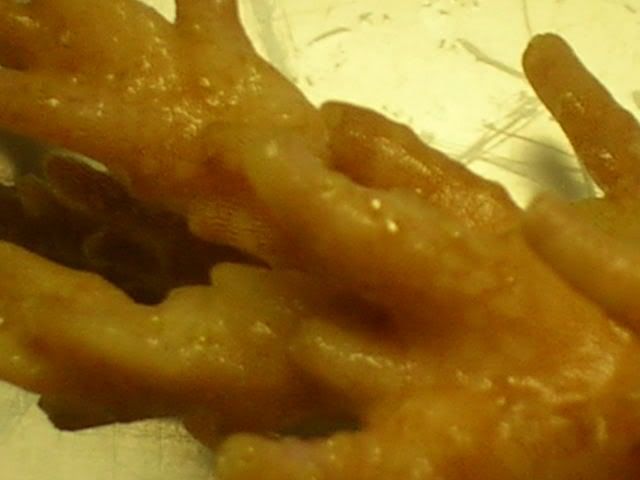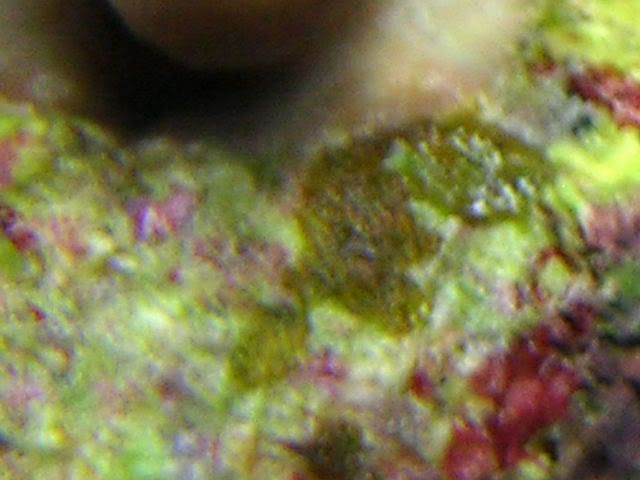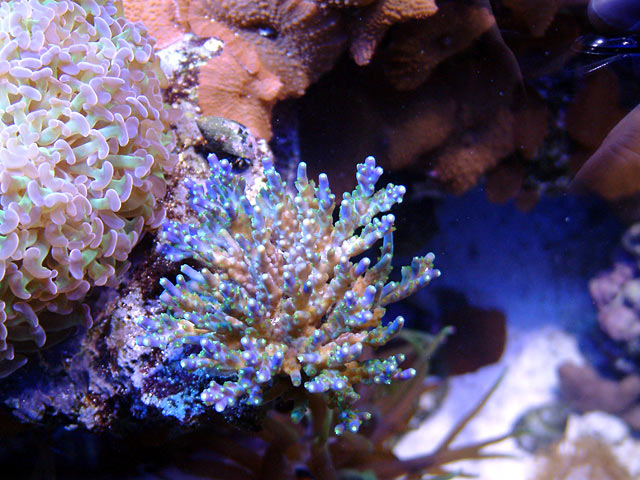

|
|
|
#76
|
|||
|
|||
|
AEFW wont touch those... SUPPOSEDLY they only eat Acropora. Im sure most will agree you will be ok with leaving those in there.
|
|
#77
|
|||
|
|||
|
That's good to know. So the tank won't be absolutely a softy tank. I don't want to get the softy guys excited or anything.

__________________
Marc Levenson - member of DFWMAS |
|
#78
|
|||
|
|||
|
Hi guys, I'm kinda new to the SPS scene, but upon reading about A. valida being one of the first to go in a tank, and me watching mine fade away, I thought I'd post a couple of pics to see if you could verify for me what I think I might already know.
 and a cluster of tiny green little round things....eggs?  I have been studying this little frag under a magnifying glass and still haven't spotted any actual FW's. If you think that I have these guys, can someone direct me towards a good treatment plan? There are hundreds and hundreds of posts on these. All I have right now is probably a half dozen or so small acro frags that would need to be treated. Would putting them in a separate tank and treating them there be the easiest? And would leaving them out of the display for a certain period kill what's in the tank? thanks for any help
__________________
Dave |
|
#79
|
|||
|
|||
|
Yes, it does look like bite marks on the coral frag.
The flatworm is very difficult to see, if you put it into a white bowl and fill with tank water, and then take a turkey baster and blast the coral the flatworms will come off.
__________________
Eileen |
|
#80
|
|||
|
|||
|
wow these buggers are everywhere ...I agree they do look like AEFW bite marks
__________________
Taking a break from the hobby ------- Feel free to use my photos for ONLY informative sites, education or enjoyment.All I ask is to include my Reef Central User id and where you got the photo ( RC). |
|
#81
|
|||
|
|||
|
The problem with locating AEFW is these little buggers suck the zooanthellae from the coral. They take on the same coloration which now makes it very difficult to spot in the tank.
These things are like little vampires.
__________________
Eileen |
|
#82
|
|||
|
|||
|
these things are everywhere. Im getting nervous because of the corelation between an interceptor treatment and the onset of AEFW...I treated for red bugs 2 weeks ago so im on high alert.
|
|
#83
|
|||
|
|||
|
Quote:
P.S. It was anecdotally reported that betadine will also actually kill the eggs and even go so far as to somewhat dislodge them, making additional removal that much easier. This came from an International RC member who's English was pretty good, but not perfect, so some things may have been lost in the translation. To date I am not aware that it has been duplicated or confimed here locally.
__________________
- Tom |
|
#84
|
|||
|
|||
|
Quote:
__________________
Dave |
|
#85
|
|||
|
|||
|
Quote:
Macropharyngodon bipartitus is frequently called an African Leopard Wrasse.
__________________
Carpe carpum. |
|
#86
|
|||
|
|||
|
melev - very very sorry to hear buddy! my valida and a unknown tricolor are lighter then ever and one shows some recession at the base...hope it's not what i think it is
 keep us up to date on what you do and find out Lunchbucket
__________________
Trying to lose weight by walking is like trying to bake a cake w/ a cigarette lighter - Lunchbucket - "Nancy-Boy Extraordinaire" - maxxII- |
|
#87
|
|||
|
|||
|
Quote:
Just closely inspect current corals in your tank and quarantine all new ones. I inspected all of mine and all new corals go into quarantine. It is preventable but I know how hard it is to quarantine... just found the perfect coral and it would look so nice up top near that other one but... must... fight... urge... 
__________________
"In all things of nature there is something of the marvelous." Aristotle Params: Sg 1.026, Alk 11 dKH, Ca 440, Mg 1450, Ph 8.4, Temp 80*F |
|
#88
|
|||
|
|||
|
shooter7, did you turkey baste in a white bowl to see if you actually have them?
__________________
180 w/ 400W Coralvue dimmable ballast / mini lumenarc reflectors / Reeflux 10K bulbs |
|
#89
|
|||
|
|||
|
After reading all these threads on AEFW I have invested in a quarantine set-up for all my incoming sps. Can you give me a recommendation on how long to quarantine......in other words about how long might it take for these "bite-marks" to be easily visible to the eye? How fast do the populations increase in your experiences?
(All the photos that have been posted are a great resource. Thank you to all that have posted them and endured the hardships that come with the pest. ) |
|
#90
|
|||
|
|||
|
Quote:
__________________
Dave |
|
#91
|
|||
|
|||
|
Quote:
Of course the treatment can't produce AEFW where none exist BUT what if they are present with the RBs and the RBs somehow inhibit/prevent the AEFWs from causing as much damage. Maybe RBs defend their acro colony from other types of predators and just get out of control numbers wise in captivity due to the lack of some natural population control. Maybe aliens from another world introduced them,who knows?  It is interesting to speculate but it does nothing for the problem at hand. Quarantine will be the best defense. The only problem is somethings are overlooked because people are not aware of what to look for until it becomes common knowledge. Because of that I guess quarantine with an assumption that it has certain things and treating as prescribed may be the smartest thing.
__________________
Carpe carpum. |
|
#92
|
|||
|
|||
|
What about acro crabs? has anyone found these fw's on colonies with crabs in them?
__________________
Gigas! Its whats for dinner! |
|
#93
|
|||
|
|||
|
Quote:
__________________
- Tom |
|
#94
|
|||
|
|||
|
I still take the stance that I don't think there is a correlation between RB's and FW's. Even if there is, I think it is still just as necessary to treat for RB's. Anyone that has seen the RB video that Borneman posted a couple years ago will know how dangerous they are to the acros. They literally bury their head right into the acro flesh and start mining away at it.
I think the red bugs have been here all along. It just wasn't until a couple years ago that people really started looking at an almost "microscopic" level for parasites on their corals. That is when the RB's were found. I also have a hunch that the AEFW's have probably been around a lot longer than we think. Even if you know you have them they are next to impossible to see on a coral. Pretty much the only way to confirm their presence is by dipping the coral. I think all along the RB's and AEFW's have been around but their damage has been blamed on other things such as husbandry, water chemistry, etc. just my $.02 |
|
#95
|
|||
|
|||
|
I would have to agree with you on pretty much all of your assertions Travis.
__________________
- Tom |
|
#96
|
|||
|
|||
|
I don't really think there is any relationship between the two. It's just interesting to see the number of people with RBs and after treatment they have AEFW. More 'n likely it's like I said that it's hard to look out for something you are unaware exists. I think the reason they are so prevalent now is the amount of SPS sells ,swaps ,trading , etc. that is done now versus in the past .I also think the culturing of these corals are also likely to be a part of it. Culturing in inland facilities without any of the natural checks would allow these pest to run rampant. Mariculturing these corals in areas that are not where they are normally found may also contribute because if they are cultured in areas away from where they naturally grow in order to make it easier to harvest there is a good likelihood that natural controls are also not found in these areas.
__________________
Carpe carpum. |
|
#97
|
|||
|
|||
|
Quote:
So anybody got advice on 20k bulbs?
__________________
Gigas! Its whats for dinner! |
|
#98
|
|||
|
|||
|
wrong thread for that humboldt. Try posting that question over in the lighting forum.

__________________
- Tom |
|
#99
|
|||
|
|||
|
Here's a picture of the infected Tyree, needing my attention. Life got busy and it was put on hold.

__________________
Marc Levenson - member of DFWMAS |
|
#100
|
|||
|
|||
|
so no treatmen in the near future??
any recession? Lunchbucket
__________________
Trying to lose weight by walking is like trying to bake a cake w/ a cigarette lighter - Lunchbucket - "Nancy-Boy Extraordinaire" - maxxII- |
|
|